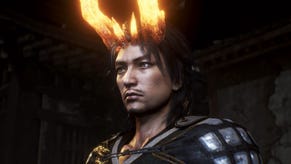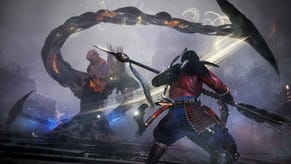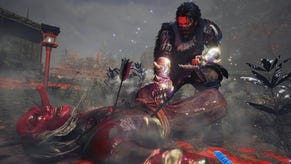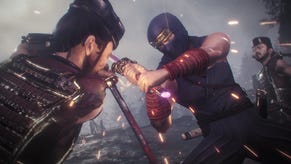Nioh PlayStation 4 Review: A Worthy Heir
Nioh mostly measures up to the high standards set by other Soulsborne games.
This article first appeared on USgamer, a partner publication of VG247. Some content, such as this article, has been migrated to VG247 for posterity after USgamer's closure - but it has not been edited or further vetted by the VG247 team.
This review started as a sea of Soulsborne puns.
"Borne-again." "Re-Borne." "New-Borne." On and on, it didn’t stop. It might sound a little callous, but after the initial batch of story missions and a smattering of extra stuff on the side, I childishly thought that idiotic wordplay would be the best way to segue into how the dark samurai semi-period piece that is Nioh pays tribute to From Software’s pitch black series of Action/RPGs. Then I nearly kicked my kid’s sippy cup through my family room window during a boss fight. I think that sentence alone does a better job of things.
Yes, Koei Tecmo’s Nioh is very much a Souls-like, and there’s no escaping it. All of the usual suspects are front and center: the tense and measured combat, the agonizing stat-building, the punitive challenge. If we’re making a checklist, Nioh has those things and even flaunts them. But I’ll save you some time and cut the chase: does Nioh stack up to the Souls games? Sure, for the most part. Does it stand on its own, though? Most definitely.
More than the other imitators so far (like the merely-ok Lords of the Fallen), Nioh gets the Souls games in ways that its contemporaries don’t thanks to combat that is surgically precise and tuned like an orchestra’s piano. When you hit that sort of meditative fugue state of being totally in the moment, attack and defense comes swiftly and cruelly, and the extra swipe of your weapon to behead whatever demon unlucky enough to get in your way is satisfying in ways that only Bloodborne itself could match.
Given the pedigree, it certainly shows that Nioh might only take a nudge or two to push it into full character action game like Team Ninja’s other, more popular output. You can pop enemy mooks into the air for multi-stab juggles if you really want to, but the short, simple combinations that can be unlocked for each weapon type aren’t meant to fight sweeping hordes of foes, just the occasional 3-on-1 when things get hairy. It’s a slower, tenser pace that still forces the player to be keyed in to it, but with several added layers.
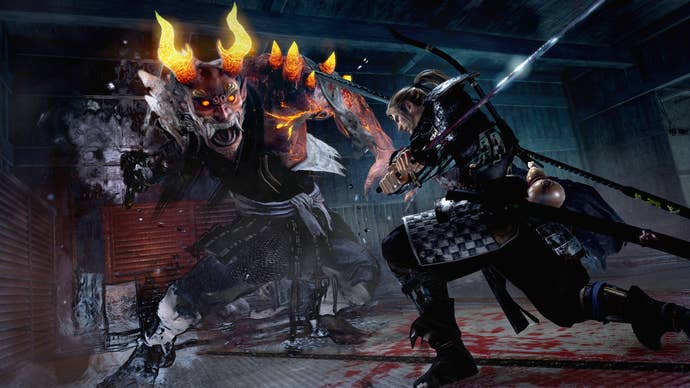
The game gives you all of the tools necessary for you to find your own combative play style even outside of the various weapons with the option to change the stance of your character. A more aggressive hold of your weapon drops your defense, but boosts attack, while holding your implement down and to the side (or even sheathed) grants faster striking and counterattacking options. Like the Ninja Gaidens and DMCs of the world, boosting stats and gaining familiarity with weapons also grants various ability points used to unlock special moves, combo extensions, and passive buffs. The skill trees extend to every weapon type, plus magic, plus the various Ninjutsu abilities.
It’s all a bit much, really. I found very quickly that I was comfortable playing a high-damage, high-mobility character build, so the vast majority of my samurai skill list was left unlocked because I couldn’t bother messing with multi-stance attack methods. The game, for its part, does its best to encourage players to nimbly move their thumbs across the controller in a complex series of movements, but I never found it necessary with careful timing and learned execution, so a slowly growing number of skill points accumulated through the endgame unallocated and unaccounted for. Opening up a nice finishing move and the occasional passive bonus is fun and rewarding, but everything else just felt unnecessary.
But maybe that’s just a byproduct of my own specific way of playing, and I say this as a compliment. Certainly, I had my share of trouble tumbling off of cliffs and getting the business end of an axe to the face, but I made it through the game skillfully and relatively fast (sippy cup-kicking notwithstanding) thanks to my prior Souls knowledge to scaffold how I was playing. But I made decisions on what gear to use –and more importantly, what to sacrifice—very early in the game.
Even now, I’m mulling over how to properly make a magic build, and then a ninja, and then a lightly armored spear-fighter, and probably fifty other things by the time you read this. Nioh’s character building and equipment farming affords you an opportunity for a lot of fun malleability. Copious loot drops mean you’re almost always juggling gear and hunting for final pieces of an armor set for extra passive bonuses, which balances out the the more RPG side of things. The more traditional Souls-like stat allocation and loot grabbing is a nice balancing act, and gives more avenues to make super powered avatars by the endgame.
The game seems to incentivize the loot extravaganza as rewards for repeated runs through missions and sub-missions, which are compartmentalized and chosen via world map. The main story missions are meaty; each took at least an hour or two to complete and are a full of tiny nooks and crannies to rummage for items. Small handfuls of friendly spirits called Kodama are littered throughout story levels and boost drops from enemies dependent on the specific spirit, which adds a nice layer of collectability.
Most stages tend to be fairly linear, all things considered, but alternate paths and shortcuts will give you a clue to their size and scope. They also tend to be more battle-focused than exploratory. Several areas have a sort of gray fog-effect that spawns large demons that tend to be stronger than the average enemy. Killing them at their spawn point means they won’t respawn if you were to die or reset the level by praying at a shrine. It’s entirely possible, though, to just sprint your way through levels and even many fog encounters, but thorough, careful exploration was always safer and more rewarding.
InterfaceGenerally unobtrusive with meters and item storage staying far away from direct field of view. Inventory management is a bit of a pain, but is small potatoes.
Lasting AppealThough the back half is a little bland, there are enough things to discover and strong characters to build that players will be kept busy for quite a while.
SoundAs the game gets less about tense exploration and more about straight action, the audio follows suit with constant booming music and dialog that goes overboard. The earlier, quieter levels could have been more judicious about its sound design.
VisualsGorgeous, especially in the optional Movie Mode that drops the frame rate in favor of a prettier game. Most players will stick to Action Mode for a smoother experience, though.
ConclusionNioh is Koei Tecmo and Team Ninja taking a more measured approach to what they do best, and is a surprisingly feature-heavy and battle-focused heir to the Soulsborne method. But it ultimately stands on its own, and is a worthy addition to any Action RPG library.

But what about the endgame?
Koei Tecmo and Team Ninja get a lot of mileage out of these story levels, too. Just about every one of them can be retaken as a sub mission for different rewards, and are usually adjusted to be shorter and with altered enemy placements. They can get a little redundant, though, when playing them back to back in large chunks, even with slightly changed lighting schemes and completion objectives. Additional sub missions will pop up on the map after completing story missions, though, and these tend to offer a bit more variety like arena fights and extra boss encounters. The recycled levels never feel tedious, though. Nioh’s stages are so full of things to look for that I’m willing to give it a pass on this. In fact, I started to skip the secondary missions in favor of finishing the story for this review, and I’m wistfully dreaming of mopping them all up even as I write this.
Sadly, these partitioned levels lack a certain sense of atmosphere. In addition, the constant dialog and sound effects that alert you when you’re spotted by a foe removes a sense of tension that would have been more effective with a liberal use of silence. This gets more lopsided by the end when music is constantly blaring in the background and quiet monster ambushes give way to more open field combat. It’s a letdown compared to the first several missions, which feel more deliberately designed.
But this back end of the game warrants some additional attention. Many of the final stages trade exploration for a larger sense of scale, but wind up being oddly more straight lines toward the specific objective. Boss encounters by this point also lose their size and are far less intimidating as the game progresses (with one specific exception), which end up feeling lazily designed. My character build and gear loadout was strong enough at that point that I could survive long enough to learn boss behaviors on the fly and finish them without significant difficulty, and they mostly felt basic and almost redundant compared to what I suffered through to get there. Like the Souls games, you can bring in another player or use an item to call in an NPC to help, but after having my reflexes so locked in enough for the first half or so of the game, I never found that I really needed the extra aid and preferred to just go it alone.
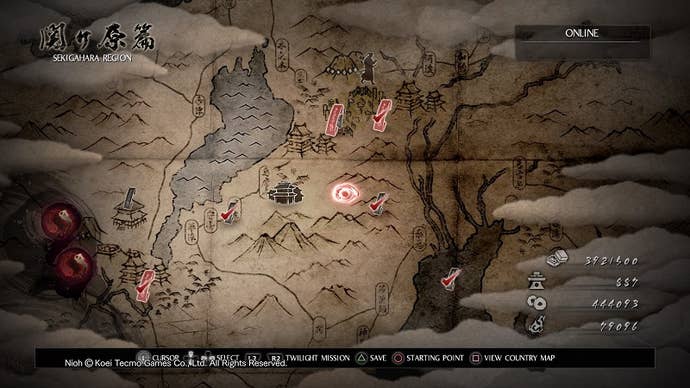
Other online capabilities never felt essential, either, but tended to be fun distractions. As the levels are confined to single areas, the designers didn’t feel the need to let other players drop messages around to point you in a specific direction (or troll you to mosey off a cliff). In their place are the graves of fallen players called Revenants. These are optional fights that you can summon in at any time, and killing them means scoring whatever gear the player was wearing when they died themselves. There are some Koei Tecmo-specific NPC Revenants placed throughout the game, too, which offer high-level gear drops or items in some handy locations. Killing them, as well as going into a mission as a co-op player, will yield reputation rewards used to purchase items and character skins from a shopkeeper unlocked midway through the game.
Strangely, though, Nioh really opens up in the postgame. Further difficulty modes are unlocked for stronger rewards, which gives it a Diablo III-like after-game loot/reward vibe. I found myself using utilities like the Blacksmith far more often for the harder modes, which is something I never touched throughout the entire main campaign and initial thought to be overkill. Again, story missions, reshuffled sub missions, and hard mode missions (not to mention the sort of quasi-hard mode Twilight Missions) is a lot of redundancy, but if you’re the kind of person that likes to crush games over their knee with meticulously constructed character builds, this game is you. It feels like the postgame stuff was made for more of the multiplayer side of things, which is due to expand into PvP after release. As of now, though, it feels like an item grind, but a fun one.
When I first approached Nioh, even during the betas that ran periodically over the last year, I felt that the game was trying to solve a problem that didn’t exist. It just kept adding more and more content on top of the thoroughly battle-tested Soulsborne formula, and it all felt superfluous. But Nioh, weak latter half aside, ultimately works. You may never use half of what you’re given, but that’s fine. There’s enough incentive to go back to them eventually.
InterfaceGenerally unobtrusive with meters and item storage staying far away from direct field of view. Inventory management is a bit of a pain, but is small potatoes.
Lasting AppealThough the back half is a little bland, there are enough things to discover and strong characters to build that players will be kept busy for quite a while.
SoundAs the game gets less about tense exploration and more about straight action, the audio follows suit with constant booming music and dialog that goes overboard. The earlier, quieter levels could have been more judicious about its sound design.
VisualsGorgeous, especially in the optional Movie Mode that drops the frame rate in favor of a prettier game. Most players will stick to Action Mode for a smoother experience, though.
ConclusionNioh is Koei Tecmo and Team Ninja taking a more measured approach to what they do best, and is a surprisingly feature-heavy and battle-focused heir to the Soulsborne method. But it ultimately stands on its own, and is a worthy addition to any Action RPG library.


